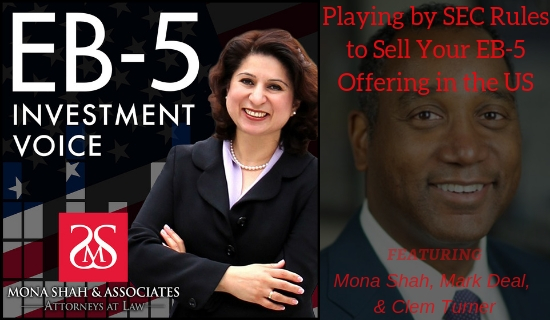
Playing by SEC Rules to Sell Your EB-5 Offering in the US with Clem Turner – Episode 72
When EB-5 investors are already in the US, project developers must play by slightly different rules. In this episode, Mona and Mark sit down with Clem Turner to discuss the ins and outs of SEC compliance when private offerings are sold inside the US. Listen in for insight around the Reg D exemption process, the verification of accredited investors, and the safety in filing Form D as a compliance measure.
Southeast Asian interest in EB-5 continues to surge, and that includes a number of Indian nationals living, working and going to school in the US on H-1B, L-1 or F-1 visas. If you are selling a private offering to EB-5 investors already in the States, the SEC requires you play by different rules. So, how does the exemption process differ between off-shore and private equity capital? And what are the potential consequences if you don’t file the appropriate paperwork in compliance with SEC regulations?
Clem Turner is an EB-5 corporate and securities attorney with 23 years of experience. He has advised numerous Regional Centers and corporations seeking EB-5 capital in industries ranging from technology to hospitality to manufacturing. Today, he joins Mona and Mark to discuss the Reg D exemption process necessary in soliciting foreign investors within the US.
Clem explains what information is included in Form D, when and to whom the paperwork should be filed, and why it is necessary with or without a PPM. Listen in for insight around verifying accredited investors and learn why the trend toward oversubscription is a concern for EB-5 investors.
Understanding the Reg D Exemption
- Reg S is the off-shore exemption that works for the majority of EB-5 deals. It proves that the investors are not in the country and that the deal was signed outside the US.
- When a private offering is sold within the US, Reg S is unavailable. For instance, someone in the States on an H-1B visa doesn’t qualify for Reg S. In this case, Reg D should be employed instead.
- Filing Form D is the official last step of the Reg D exemption process, and it is required from a compliance perspective. So far, the SEC has not enforced a consequence for failing to file Form D, but USCIS is likely to send an RFE in its absence.
The Fundamentals of Form D
- If you are doing a project on your own, you may choose to put together a PPM or employ another means of disclosure. But remember, the PPM is a matter of content, while Reg S and Reg D deal with process. Therefore, filing Form D is necessary with or without a PPM.
- Form D includes information about the issuer, the owners of the issuer, and the states in which the offering has been made. It also requires the names and contact information of any broker-dealers involved as well as their FINRA numbers.
- Form D is a federal form. However, once you secure an investor from a particular state, you must also give that state notice by sending an updated Form D and paying a fee.
- Form D should be filed within 15 days of the first sale and again at the end of the offering to amend the original. If the process takes more than a year, Clem recommends submitting annual updates to the SEC.
The Safety in Following Reg D
- If you go in on a project with a small group of friends, you can either classify your offering as a Reg D-exempted transaction or as an old-fashioned private placement under Rule 42 of the securities laws. If you choose the first option, you must file Form D.
- If you utilize an old-fashioned private placement, you are not sheltered by Reg D should something go wrong with the project. For example, a lack of Form D could be used as part of the argument for an investor suing for rescission—to get out of a deal.
Verifying Accredited Investors
- Under the new rules of Reg D in the Jobs Act, a project using crowd financing requires third-party verification. This means that an accountant, lawyer or financial planner must confirm that each investor meets the net worth requirements to be considered accredited.
- If you use the original Reg D exemption, you are allowed to rely on a simple questionnaire to verify that investors meet net worth requirements. Most EB-5 projects work from these old rules, but keep in mind that Form D is required either way.
The Concerns Around Oversubscription
- When project developers continue to raise capital after a project is full, that is known as oversubscription. Clem believes this is happening because of concerns that some investors will be denied or pull out of the project.
- Within the context of EB-5, oversubscription presents a problem with regard to the job cushion. If, for example, you start with a relatively safe 20% cushion, but oversubscription reduces the cushion to 15%, you should send out a notice and get consent from the investors who have already signed on to the project.
